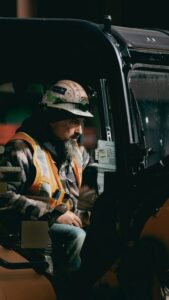The mining industry is evolving, and with it, so is the workforce. As workers remain in the labor force longer, mining companies face unique challenges in ensuring the safety of their aging workforce. Tailoring mining safety training to meet the needs of older employees is essential to protect their well-being and maintain operational efficiency.
This article explores the unique safety challenges faced by an aging workforce, the impact of age-related changes, and actionable strategies for adapting safety training. By addressing these issues, the mining industry can foster a safer, more inclusive work environment for employees of all ages.
Understanding the Unique Safety Challenges of an Aging Workforce
As workers age, they may encounter physical and cognitive changes that affect their ability to perform certain tasks safely. These challenges include slower reaction times, reduced strength, and greater susceptibility to injuries. In the mining industry, where physical labor and quick decision-making are essential, these changes can increase the risk of accidents.
Additionally, older workers may be more prone to chronic health conditions, such as arthritis or cardiovascular issues, which could affect their performance. Tailoring safety training to address these challenges is crucial for reducing risks and maintaining productivity.
The Impact of Age-Related Physical and Cognitive Changes on Workplace Safety
Age-related changes can have a direct impact on workplace safety in the mining industry. Some common changes include:
- Reduced Strength and Mobility: Mining tasks often involve heavy lifting, climbing, or long periods of standing, which can be challenging for older workers.
- Slower Reaction Times: Delayed responses to hazards or emergencies may increase the risk of injuries.
- Decreased Vision and Hearing: Impaired sensory perception can affect an employee’s ability to detect dangers, such as machinery malfunctions or falling debris.
- Cognitive Decline: Challenges with memory or problem-solving can impact an older worker’s ability to follow complex safety procedures.
Recognizing these changes and addressing them through targeted safety training is essential to protecting older employees.

Adapting Training Methods to Suit the Needs of Older Workers
Standard safety training methods may not be effective for an aging workforce. To ensure older workers can fully engage with and retain critical safety information, training programs should incorporate:
- Simplified Content: Use clear, concise language and avoid overly technical jargon.
- Interactive Training: Hands-on learning, such as simulations or role-playing scenarios, can help older workers better understand and apply safety protocols.
- Frequent Refreshers: Regularly revisiting training topics ensures retention and reinforces best practices.
- Flexible Schedules: Provide training options at times that accommodate older workers’ physical and cognitive needs.
By tailoring training methods to suit the needs of older employees, mining companies can enhance both safety and productivity.
Leveraging Technology to Enhance Safety Training for Older Employees
Technology offers innovative solutions for improving safety training for aging workers. Interactive tools, such as virtual reality (VR) simulations, allow employees to experience real-life scenarios in a controlled environment. These tools can help older workers practice hazard identification and emergency responses without physical strain.
Additionally, mobile applications and e-learning platforms enable workers to access training materials at their own pace, making it easier to accommodate diverse learning styles. Wearable technology, such as smart helmets or fitness trackers, can also monitor physical health and provide real-time feedback, helping older employees stay safe on the job.
Best Practices for Implementing Tailored Safety Training Programs
To ensure the success of age-specific safety training programs, mining companies should follow these best practices:
- Conduct Needs Assessments: Evaluate the specific challenges and requirements of older workers to design targeted training programs.
- Involve Employees: Seek input from older workers to understand their concerns and preferences.
- Collaborate with Experts: Partner with occupational health specialists or ergonomists to develop effective training strategies.
- Pilot Programs: Test new training methods with a small group before implementing them across the workforce.
- Measure Outcomes: Regularly evaluate the effectiveness of training programs and make adjustments as needed.
The Role of Ergonomics in Reducing Workplace Injuries Among Older Workers
Ergonomics plays a crucial role in minimizing the physical strain on aging workers. By designing tools, equipment, and workspaces that accommodate the needs of older employees, mining companies can reduce the risk of injuries.
Examples of ergonomic improvements include:
- Adjustable seating and workstations
- Anti-fatigue mats for standing tasks
- Lighter tools with ergonomic handles
- Improved lighting to enhance visibility
Incorporating ergonomic solutions into safety training ensures that older workers can perform their tasks comfortably and efficiently.
Creating a Safety Culture That Supports Employees of All Ages
A safety-first mindset should be inclusive of all employees, regardless of age. Fostering a supportive safety culture involves:
- Encouraging open communication about safety concerns
- Providing ongoing training and resources for workers of all ages
- Recognizing and celebrating employees’ contributions to workplace safety
When workers feel valued and supported, they are more likely to adhere to safety protocols and contribute to a safer work environment.
Successful Safety Training Initiatives in Mining Operations
Mining companies worldwide have successfully implemented tailored safety training programs to address the needs of an aging workforce. For example, some organizations have introduced VR training simulations that allow older workers to practice emergency response scenarios in a risk-free environment.
Other companies have focused on mentorship programs, pairing older workers with younger colleagues to share knowledge and promote safety best practices. These initiatives highlight the value of experience and foster intergenerational collaboration.
The Legal and Ethical Considerations of Tailoring Safety Training for Older Workers
Tailoring safety training for older employees is not only a practical decision but also a legal and ethical obligation. Employers must comply with age discrimination laws while providing reasonable accommodations to ensure the safety of all workers.
Ethically, mining companies have a responsibility to protect their employees and promote equity in the workplace. Tailored safety training demonstrates a commitment to inclusivity and respect for workers of all ages.
Measuring the Effectiveness of Age-Specific Safety Training Programs
To gauge the success of age-specific safety training, mining companies should track key performance indicators (KPIs) such as:
- Reduction in workplace injuries among older workers
- Employee feedback on training effectiveness
- Compliance rates with safety protocols
Regular evaluations and data analysis help identify areas for improvement and ensure that training programs continue to meet the needs of aging employees.
Building a Safer, More Inclusive Future for an Aging Workforce in Mining
As the mining industry evolves, so must its approach to safety. By tailoring safety training for an aging workforce, companies can create a safer, more inclusive environment that values the contributions of employees of all ages.
Investing in innovative training methods, ergonomic solutions, and supportive safety cultures not only protects workers but also enhances operational efficiency. Together, these efforts will help the mining industry build a safer future for everyone.

